Edith Weston is a village and civil parish in the county of Rutland in the East Midlands of England. The population of the civil parish was 1,042 at the 2001 census, including Normanton and increasing to 1,359 at the 2011 census.[3] It is on the south-eastern shore of Rutland Water and is home of the main sailing club and a fishing lodge.[4] The village is named after Edith of Wessex (1029–1075), the queen of Edward the Confessor and sister of Harold Godwinson.
| Edith Weston | |
|---|---|
 View towards the Church of St Mary the Virgin across Rutland Water from the Hambleton Peninsula | |
Location within Rutland | |
| Area | 2.89 sq mi (7.5 km2) [1] |
| Population | 1,042 2001 Census[2] |
| • Density | 361/sq mi (139/km2) |
| OS grid reference | SK927053 |
| • London | 82 miles (132 km) SSE |
| Unitary authority | |
| Shire county | |
| Ceremonial county | |
| Region | |
| Country | England |
| Sovereign state | United Kingdom |
| Post town | OAKHAM |
| Postcode district | LE15 |
| Dialling code | 01780 |
| Police | Leicestershire |
| Fire | Leicestershire |
| Ambulance | East Midlands |
| UK Parliament | |
The Grade I listed church[5] is dedicated to St Mary the Virgin and includes stained glass by Paul Woodroffe and Hugh Arnold; the organ is by Samuel Green of London and dated 1787.
The village pub is the Wheatsheaf on King Edward's Way.
St George's Barracks is located to the south and east of the village; this was previously RAF North Luffenham. In August 2007 16th Regiment Royal Artillery, equipped with the Rapier FSC, moved here from Woolwich.

Edith Weston features in the Alan Sillitoe novel Down From the Hill, with the main character stopping off in the Wheatsheaf for a shandy.
Edith Weston Hall edit
Edith Weston Hall was a former country house built in an Elizabethan style by the architect Lewis Vulliamy for the Rev. Richard Lucas in 1830, replacing the Old Hall which stood near the church. He died in 1846 and was succeeded by his son Richard Lucas, High Sheriff of Rutland for 1847, who passed it on to his brother George Vere Lucas, who took the surname of Braithwaite under the terms of a will. His son Major Ernest Lucas Braithwaite (also High Sheriff in 1902) sold the estate in 1904 to his nephew, Stafford Vere Hotchkin. In 1913 the latter sold the estate lands by auction and then in 1922 sold the Hall and Park to F. T. Walker of Norton Lees, Derbyshire, although the hall had been destroyed by fire in 1920. He sold them in 1924 to T. J. Burrowes, who sold them to Lieut.-Col. Francis Henry Hardy, who restored the hall in 1924 as the residence of the Hardy family.[6] It was demolished in 1954.[citation needed]
See also edit
References edit
- ^ "A vision of Britain through time". University of Portsmouth. Retrieved 7 February 2009.
- ^ "Rutland Civil Parish Populations" (PDF). Rutland County Council. 2001. Archived from the original (PDF) on 12 October 2007. Retrieved 8 February 2009.
- ^ "Civil Parish population 2011". Neighbourhood Statistics. Office for National Statistics. Retrieved 24 June 2016.
- ^ "Rutland Sailing Club Website". Rutland Sailing Club. Retrieved 21 March 2009.
- ^ Historic England. "Details from listed building database (1073962)". National Heritage List for England. Retrieved 28 September 2015.
- ^ "Victoria County History, Rutland / A History of the County of Rutland". British History Online. Retrieved 15 April 2013.
